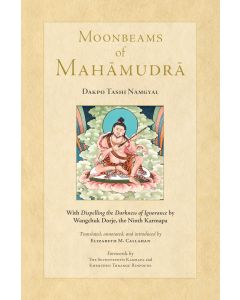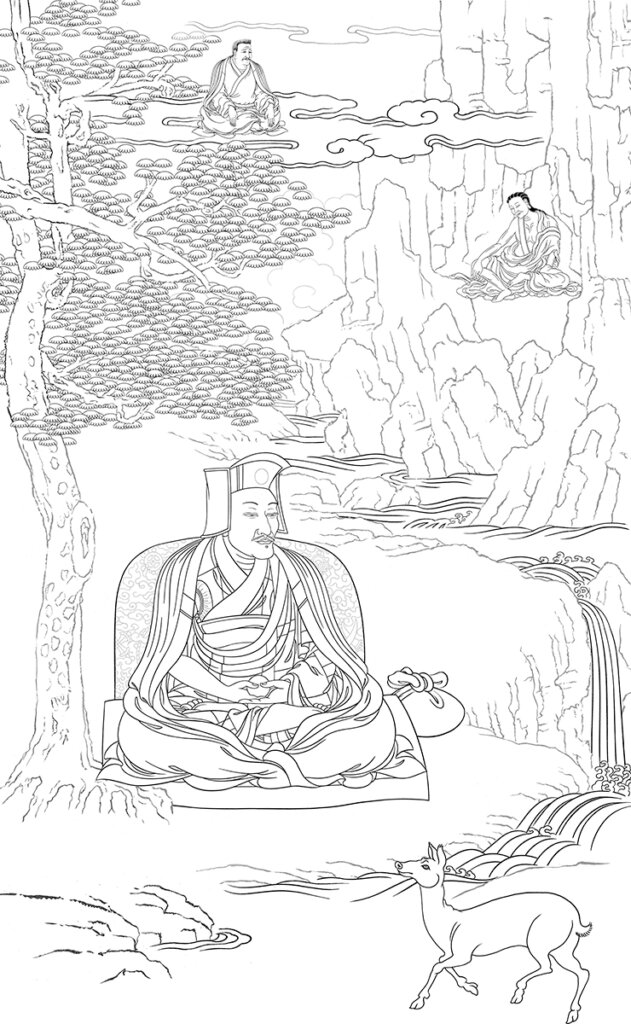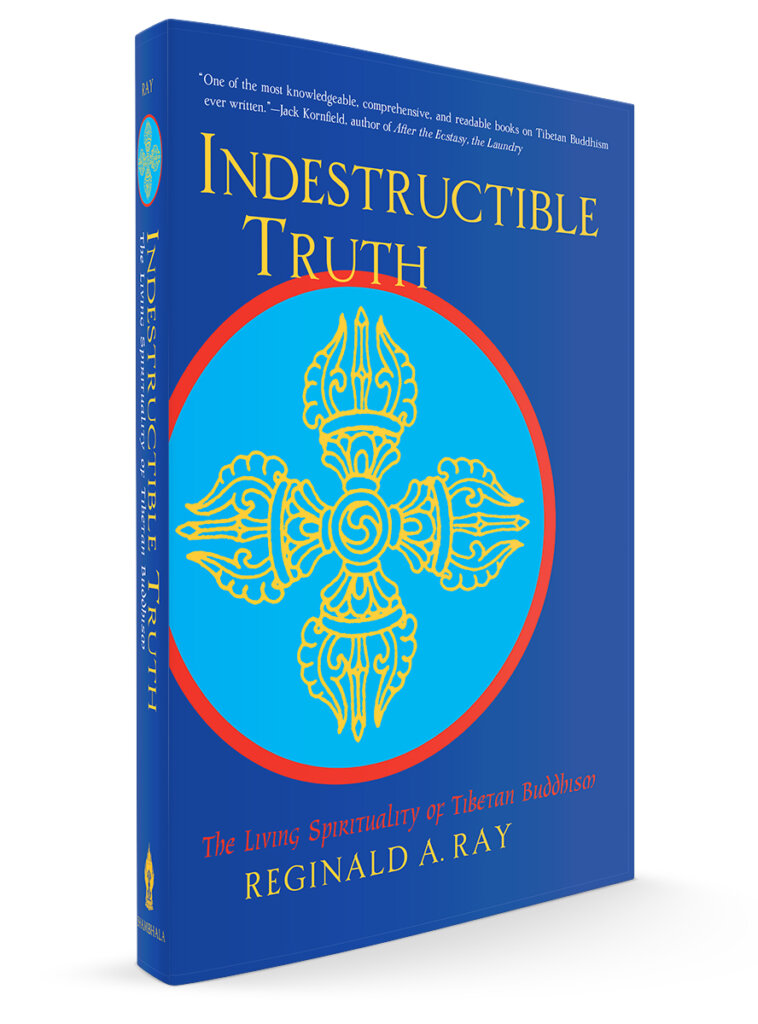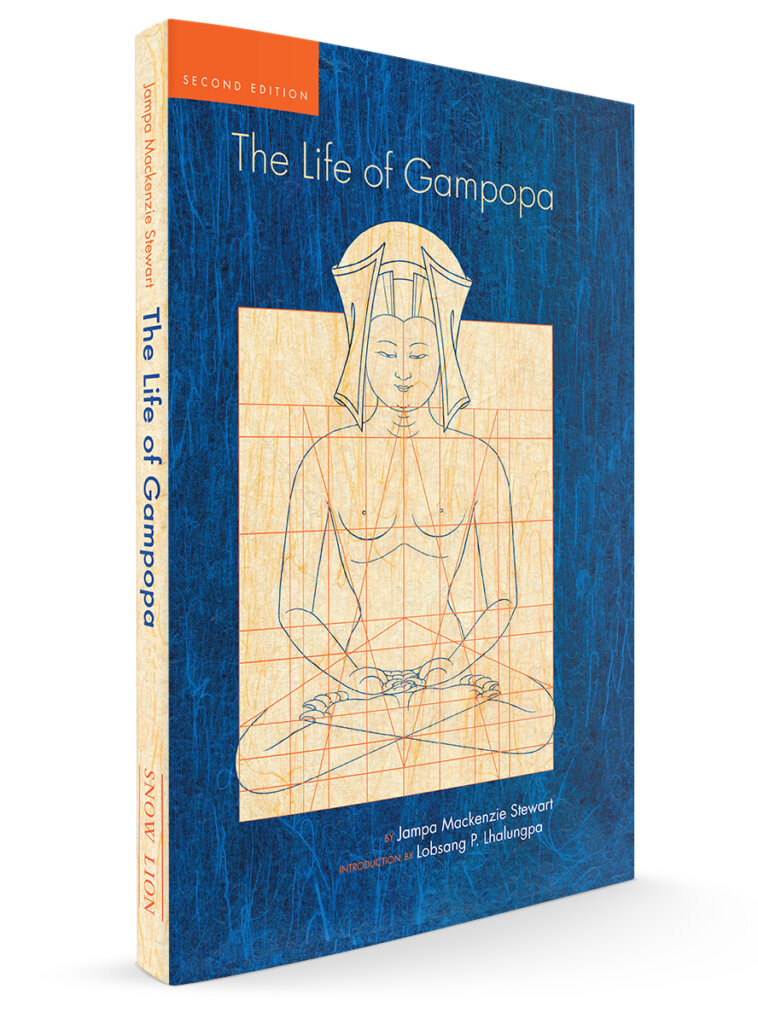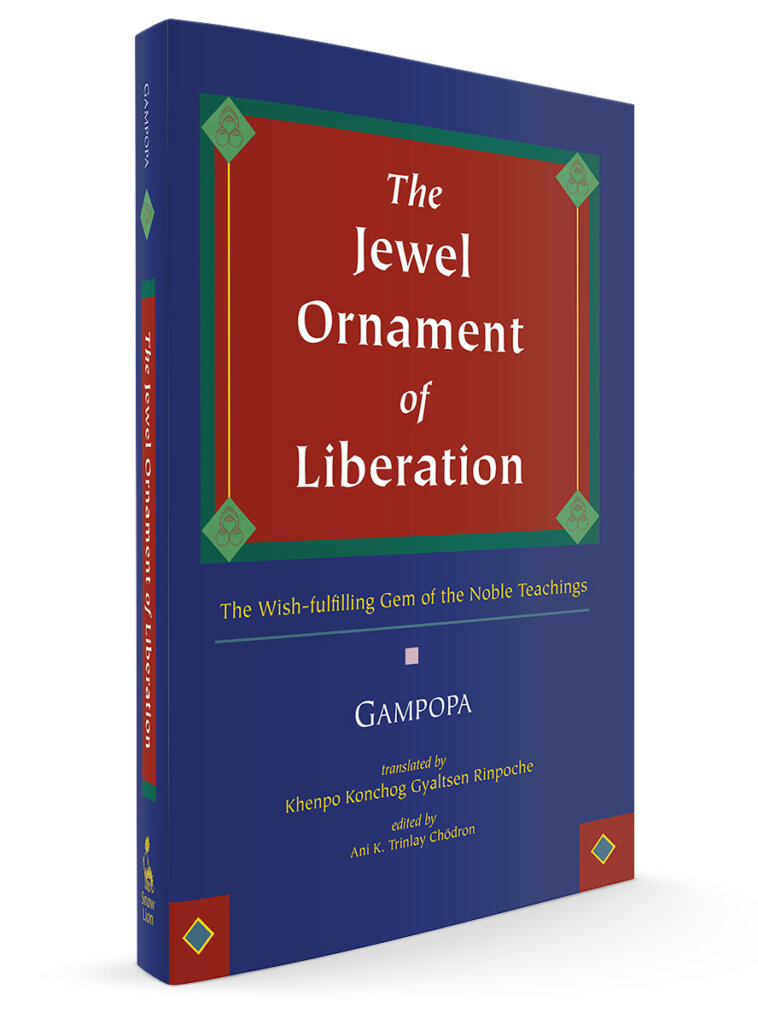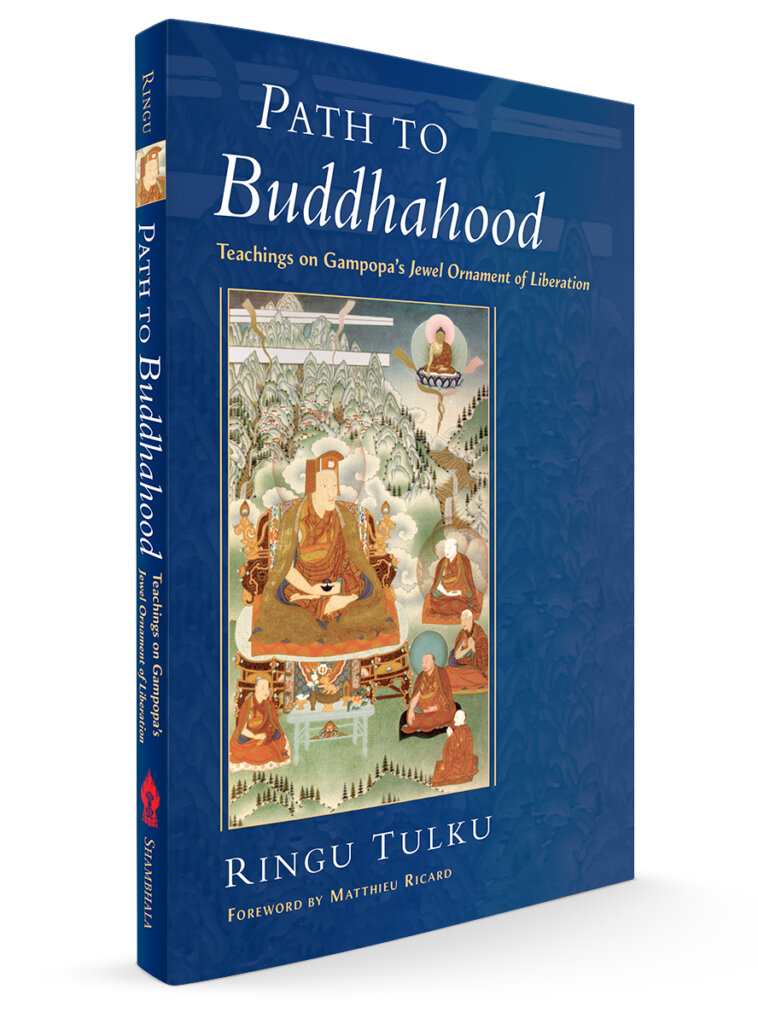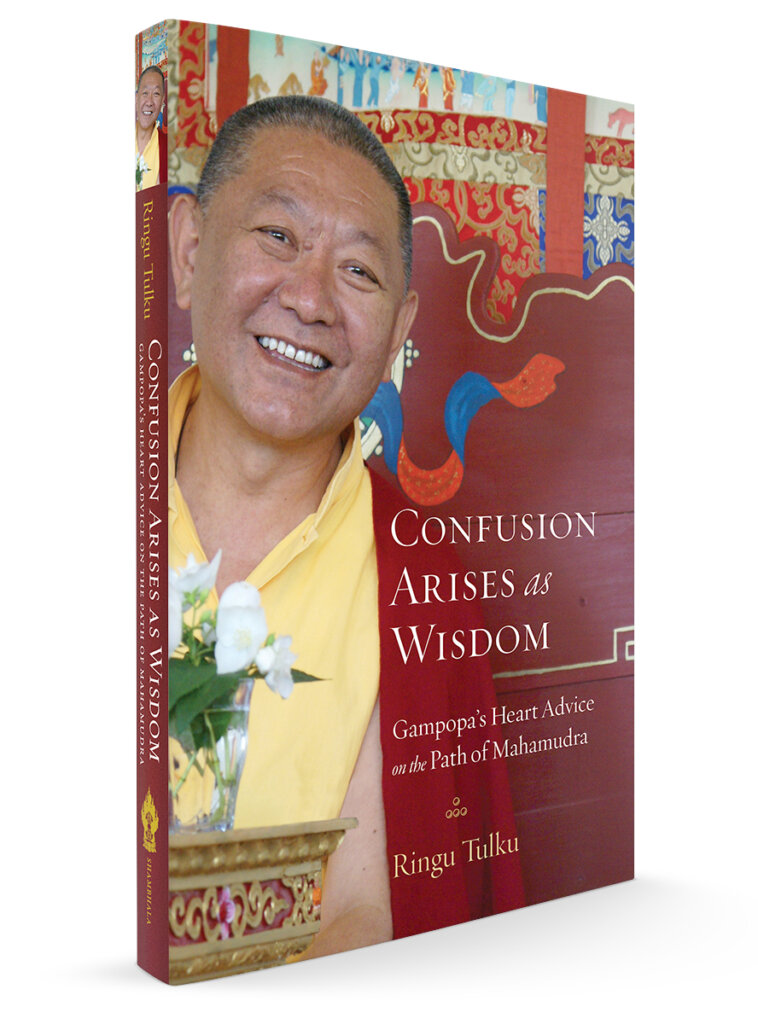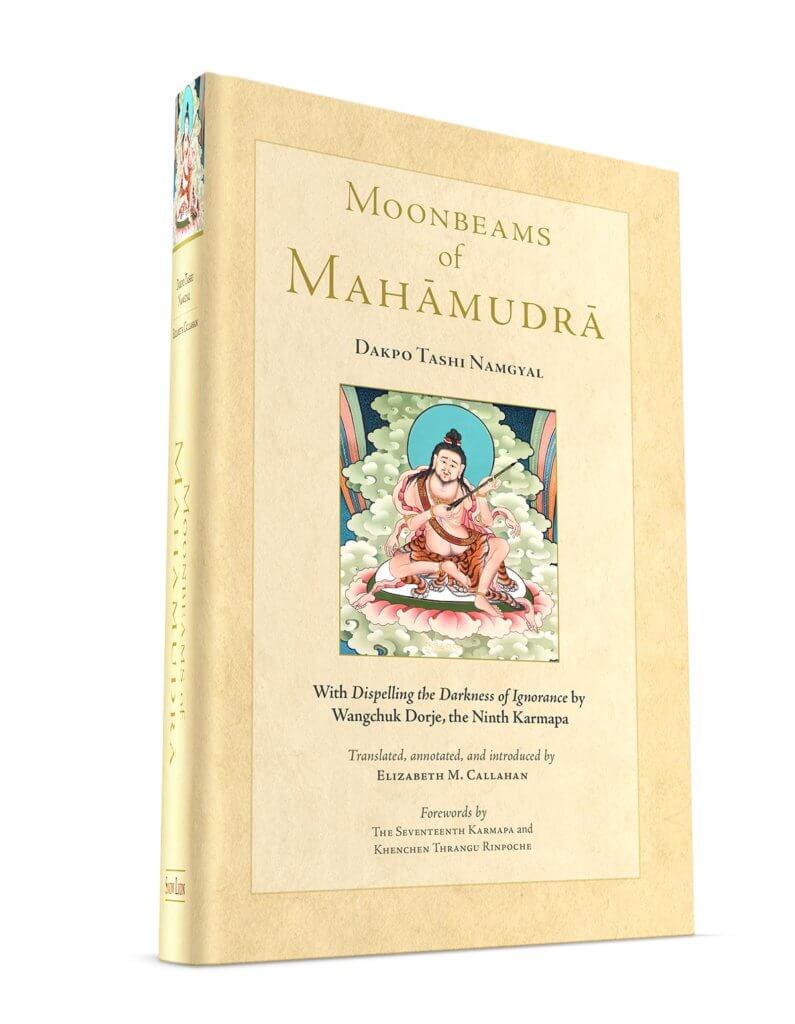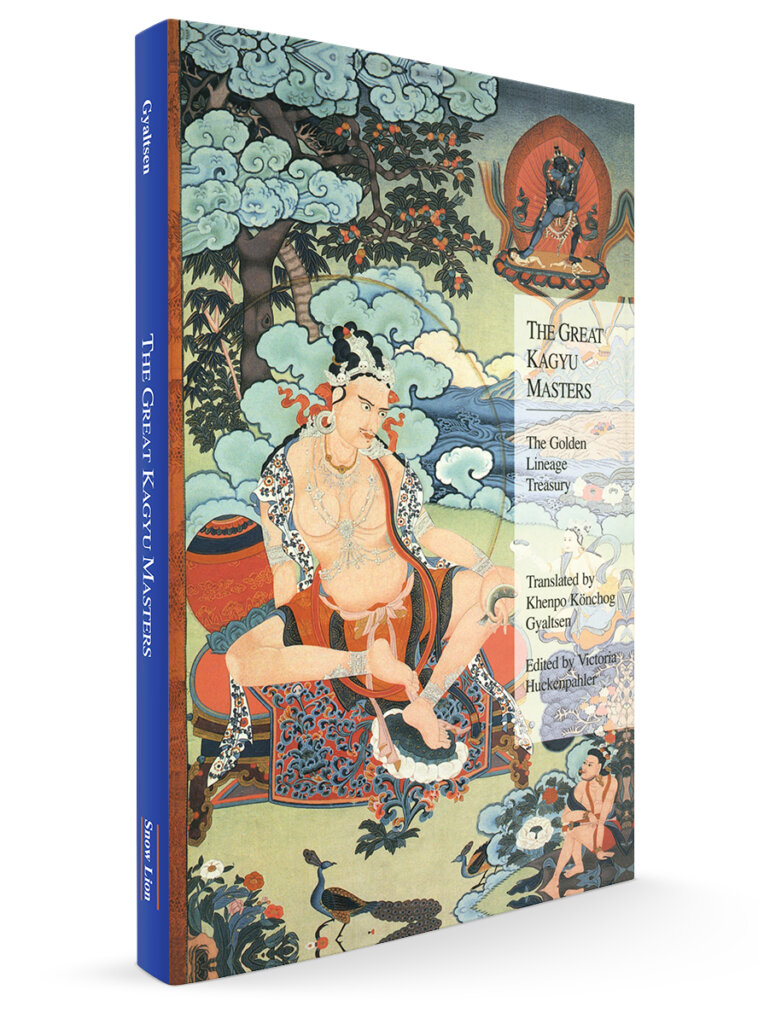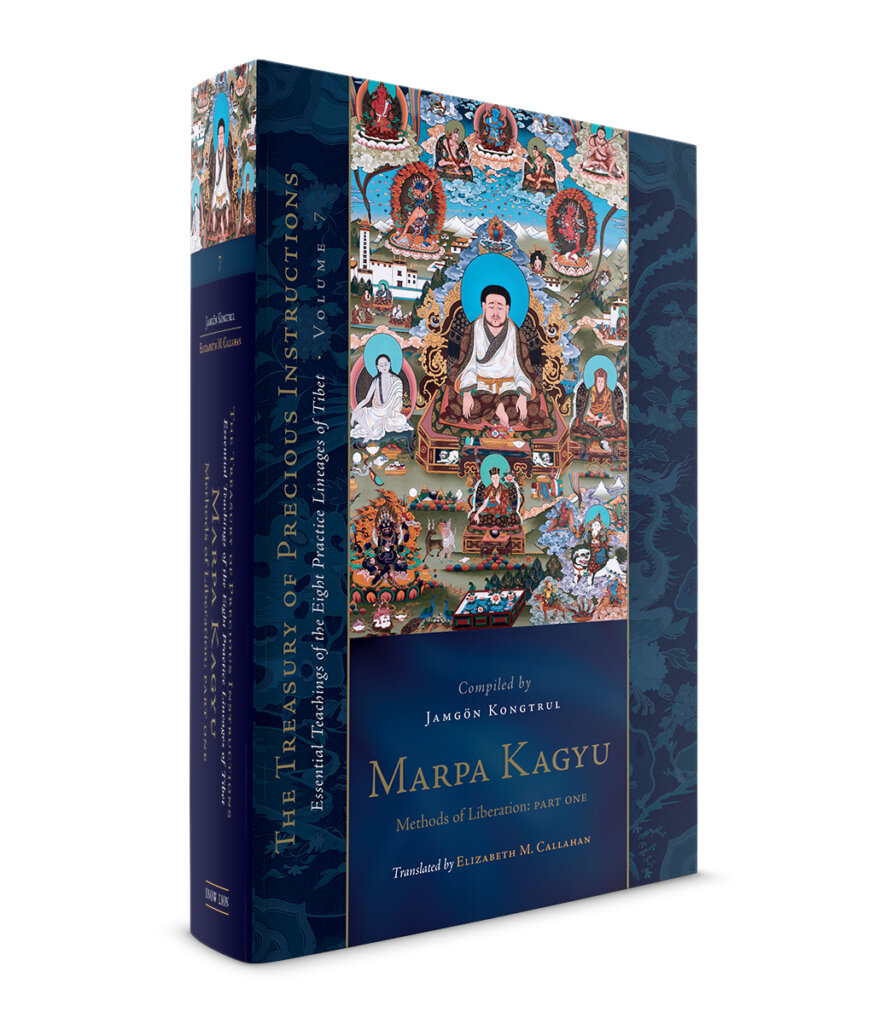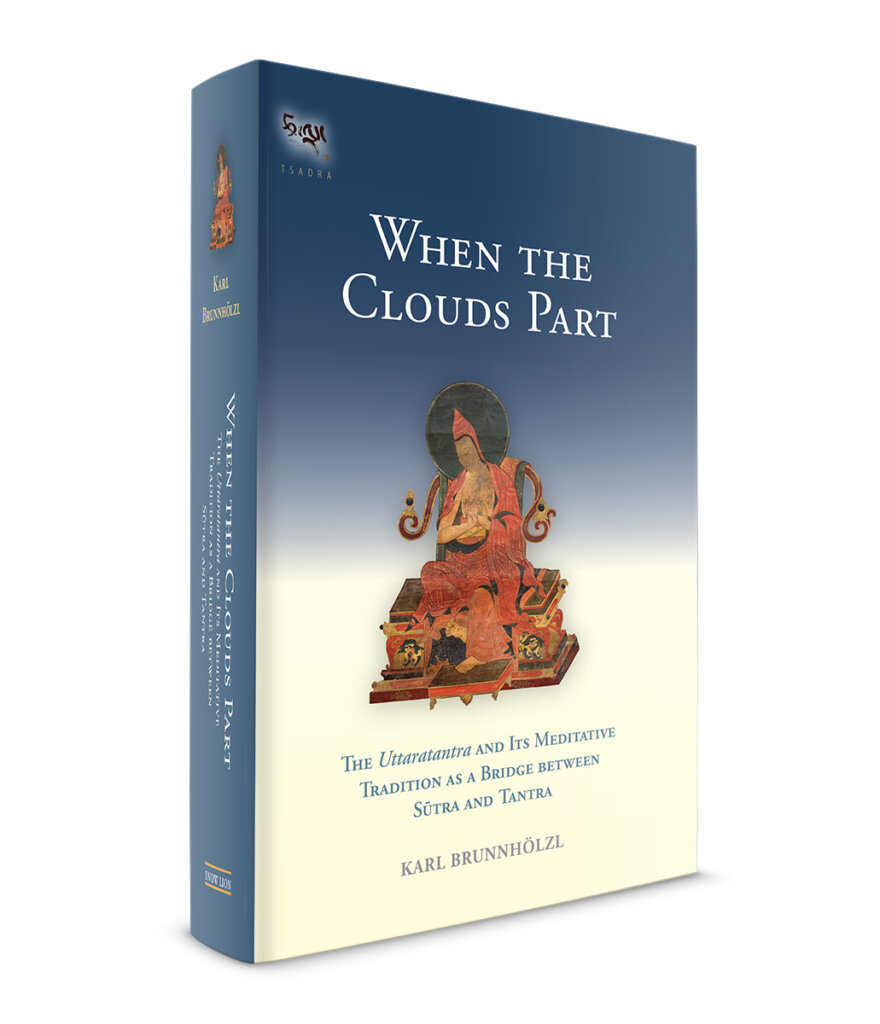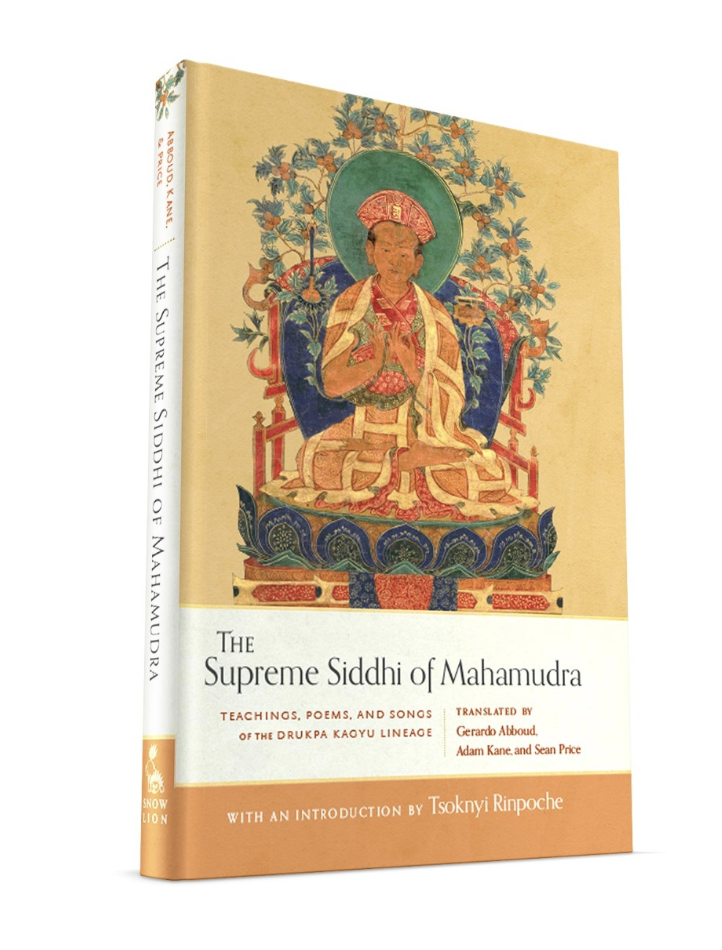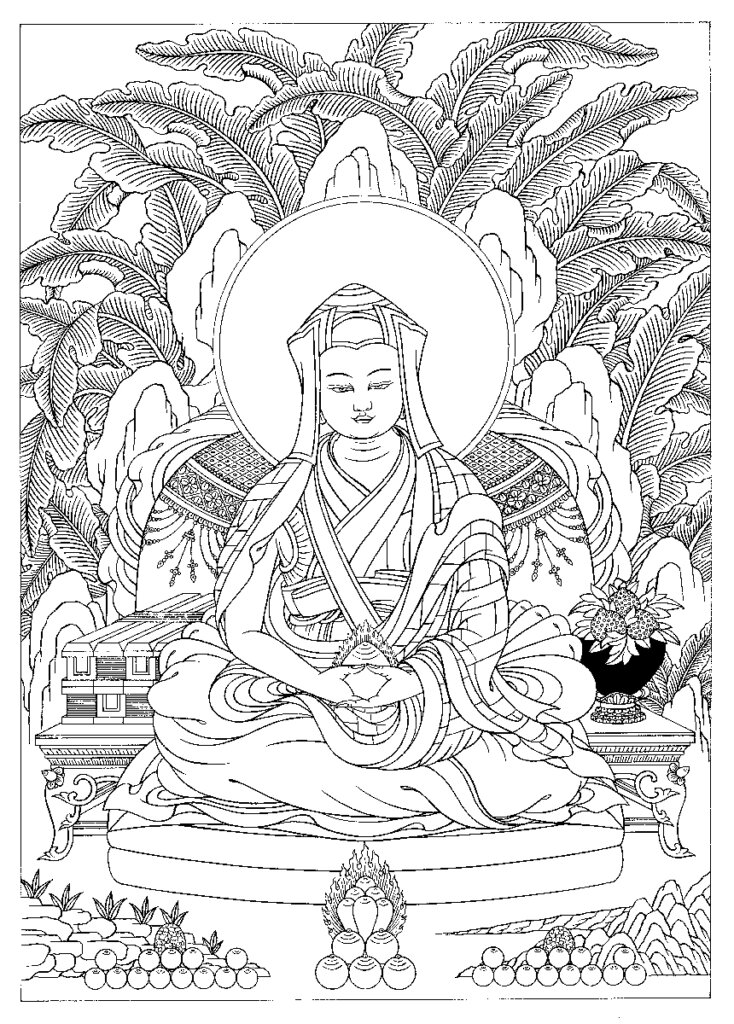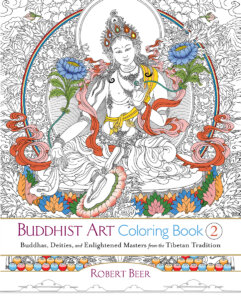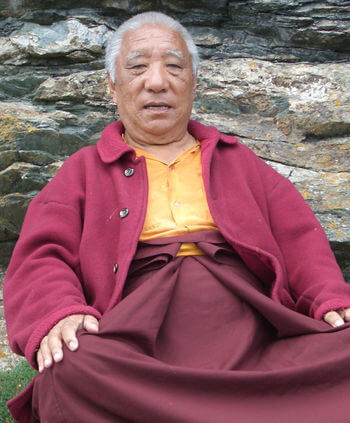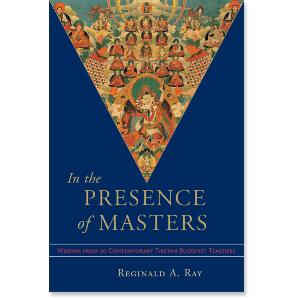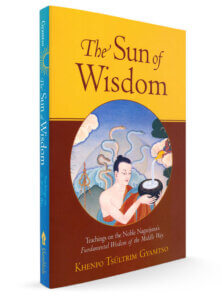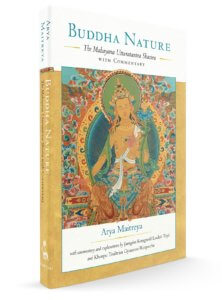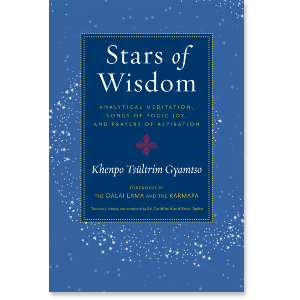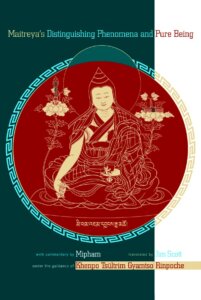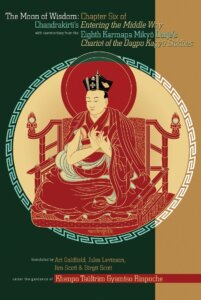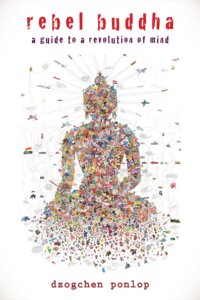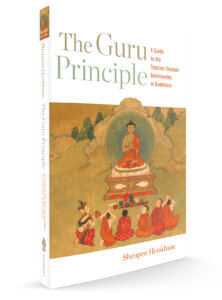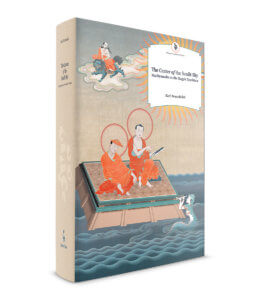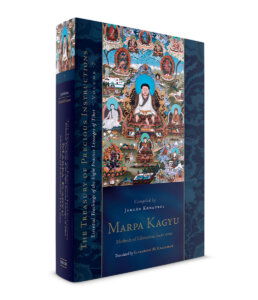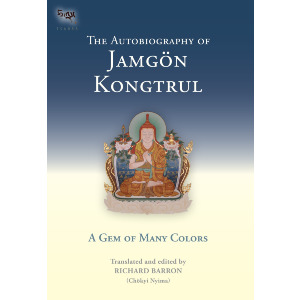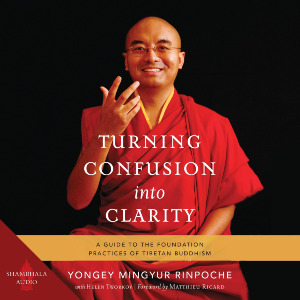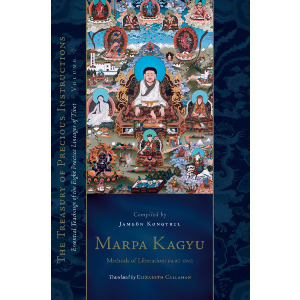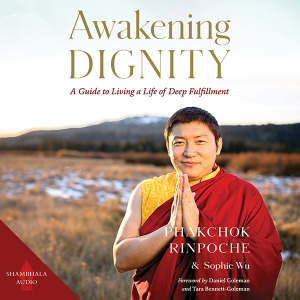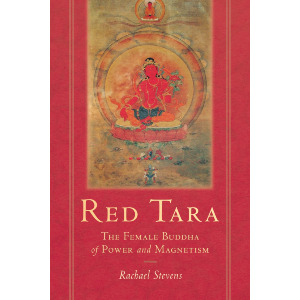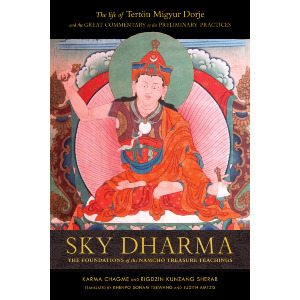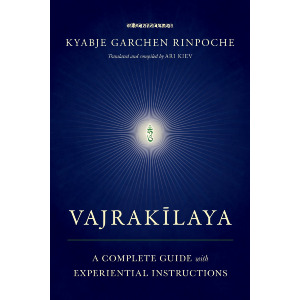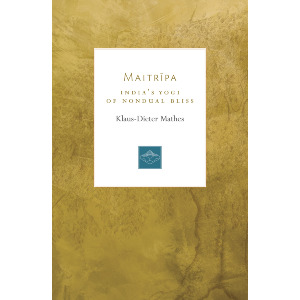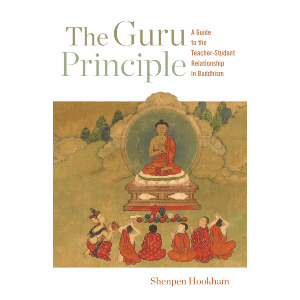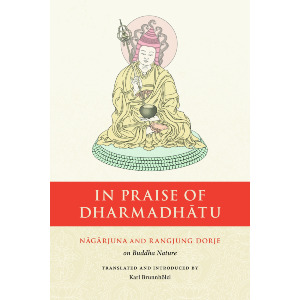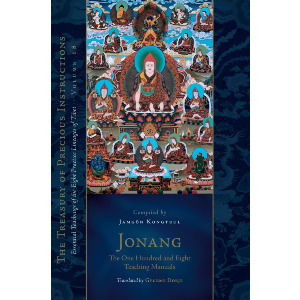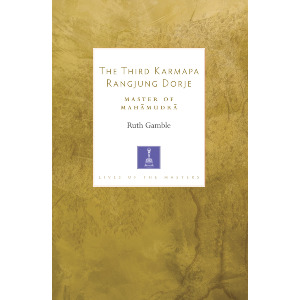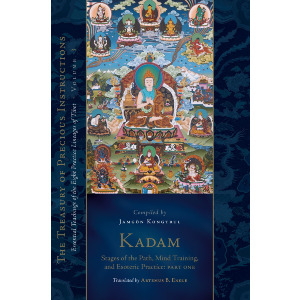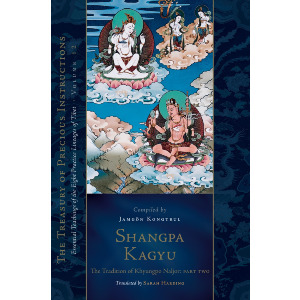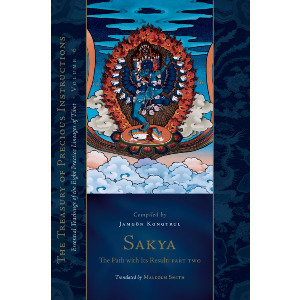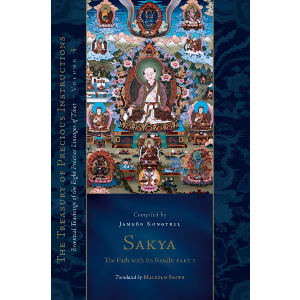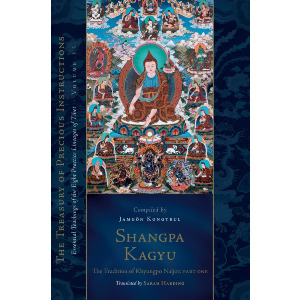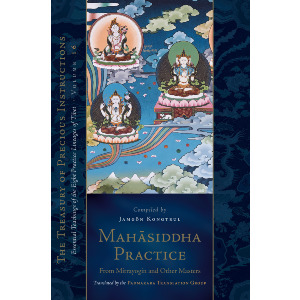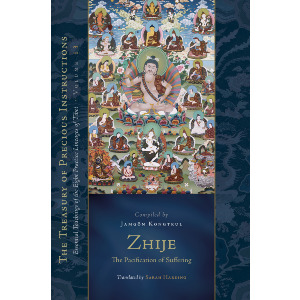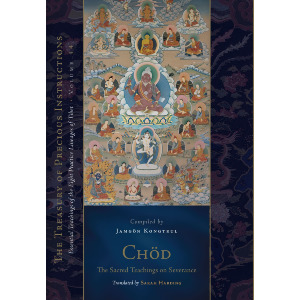Elizabeth M. Callahan
Elizabeth M. Callahan is a Tibetan translator of the Kagyu tradition. She completed two three-year retreats in the Karma Kagyu tradition under the guidance of Kalu Rinpoche, is a student of Khenpo Tsültrim Gyamtso Rinpoche, and has been a Tsadra Foundation Fellow since 2002. Her previous translations include The Treasury of Knowledge: Frameworks of Buddhist Philosophy by Jamgön Kongtrul and The Profound Inner Principles by the Third Karmapa Rangjung Dorje
Elizabeth M. Callahan
-
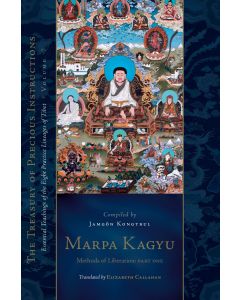 Marpa Kagyu, Part One$49.95- Hardcover
Marpa Kagyu, Part One$49.95- HardcoverBy Jamgon Kongtrul Lodro Taye
Translated by Elizabeth M. Callahan -
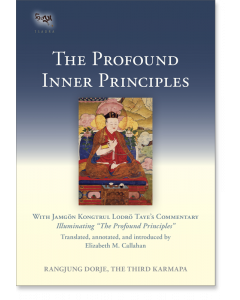 The Profound Inner Principles$49.95- Hardcover
The Profound Inner Principles$49.95- HardcoverBy The Third Karmapa
Translated by Elizabeth M. Callahan -
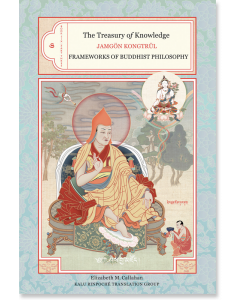 The Treasury of Knowledge: Book Six, Part Three$44.95- Hardcover
The Treasury of Knowledge: Book Six, Part Three$44.95- HardcoverBy Jamgon Kongtrul Lodro Taye
Translated by Elizabeth M. Callahan
- Treasury of Precious Instructions 1 item
- Buddhist Academic 2item
- Buddhist History 1 item
- Buddhist Overviews 2item
- Buddhist Philosophy 2item
- Dependent Origination 1 item
- Women in Buddhism 1 item
- Buddha Nature 1 item
- Deity Practice 1 item
- Kagyu Tradition 3item
- Karmapas 1 item
- Madhyamaka 1 item
- Mahamudra 1 item
- Nyingma Tradition 1 item
- Tantra 1 item
- Restricted Texts Requiring Prerequisites 1 item
GUIDES

The following short biography of Gampopa is adapted from Indestructible Truth: The Living Spirituality of Tibetan Buddhism:
In terms of the institutional continuity of the Kagyu¨ lineage, Gampopa was Milarepa’s most influential disciple. He was born in 1079 in the region of Takpo and is hence also known as Takpo Lhaje (the Doctor from Takpo). His biography tells us that, as a young man, he marries and has one child. However, while he is still in his mid-twenties, a plague sweeps through the region, and both his wife and child die. Disconsolate, with a new and vivid understanding of death, he realizes that seeking ordinary happiness in the world makes no sense and is doomed to failure. From this realization comes his decision, at the age of twenty-five, to renounce the world and enter monastic life.
Gampopa enters the Kadam tradition of Atisha and pursues a life defined by following the monastic Vinaya, studying the main scholarly traditions of Buddhism, and practicing meditation. His support is provided by some land that he continues to own. One spring, he has entered retreat in a hut built near the monastery. On a certain day, having come out of retreat and walking in the monastic grounds, he hears three beggars talking. The first expresses a desire for plentiful food and drink, while the second says he would like to be a king like Tsede of Tibet.
The third, however, comments, "Even Tsede will one day die, so his happiness is not lasting. As long as you are going to wish, wish to become a great yogin like Milarepa who needs no clothing or human food. He is fed nectar by the Dakinis, rides atop a white snow lion, and flies in the sky. Now that would be truly wondrous."
"Merely by hearing the name of Milarepa the hair of Gampopa’s body stood on end, tears came to his eyes and a special devotion, unlike he had ever felt before, emerged in his mind." Initially, his upsurge of feeling paralyzes him, and he is unable to move. When he eventually returns to his retreat hut, he is unable to meditate but keeps thinking constantly and obsessively about Milarepa. He returns to the monastery, locates the three beggars, and questions them about the person, the teachings, and the location of Milarepa. They direct him to a mountainous region in western Tibet where Milarepa is in retreat. Selling his land for four ounces of gold, Gampopa sets off to find his master.
At this point in Indestructible Truth, the meeting between Gampopa and Milarepa is recounted by Kalu Rinpoche. It then continues:
Gampopa’s path included the strict disciplinary and scholarly training of the monk as well as the meditation of the yogin in solitary retreat. In his person and in the teachings he gave, Gampopa expressed the integrated combination of these two strands, something that was unusual in Tibet at that time. This integration is laid out in his Jewel Ornament of Liberation, a work on the stages of the path that has enjoyed great fame throughout Tibetan Buddhist history and is still popular today. It was Gampopa’s mission to institutionalize this integration of his Kadam and Kagyu¨ training. In fulfillment of this, he built a monastery and ordained his main disciples. According to his biography, almost all of his primary disciples were ordained monks, following the Vinaya.
Essential Texts by and about Gampopa
Paperback | Ebook
$19.95 - Paperback
The Life of Gampopa, Second Edition
By Jampa Mackenzie Stewart, illustrated by Eva Van Dam, introduction by Lobsang Lhalungpa
Here is the first complete life story of Gampopa, foremost disciple of Milarepa and a forefather of the Kagyu lineages. Compiled from numerous Tibetan biographies, this comprehensive and inspiring rendition highlights the extraordinary details of Gampopa's meditative experiences and presents direct insights into the practice and realization of Mahamudra. Includes a history of the Kagyu and an essay on Mahamudra.
A history of the Kagyu order by Lobsang P. Lhalungpa augments Gampopa's biography, illustrating this revered teacher's central role in the development of the Tibetan
Kagyu lineages. A concluding essay on Mahamudra introduces Vajrayana Buddhism to beginners, while simultaneously supporting advanced practitioners with fresh insights.
Jewel Ornament of Liberation
The Jewel Ornament of Liberation (Tibetan: དམ་ཆོས་ཡིད་བཞིན་གྱི་ནོར་བུ་ཐར་པ་རིན་པོ་ཆེའི་རྒྱན, Wylie: dam chos yid bzhin nor bu thar) is Gampopa's most famous text. As His Holiness the Dalai Lama says in his forewrod to the translation below:
This text is an excellent work that reflects the blending of two systems of teaching-the Kadampa tradition and the Mahamudra tradition. Gampopa received complete transmissions of Jowo Je' s Lamrim tradition and Naropa' s Mahamudra tradition. This text is therefore a Lamrim text and reflects the Madhyamika philosophical view, but it also implicitly reflects the teachings of Annuttarayoga Tantra and Mahamudra. Mahamudra is not explained explicitly, however, as this is a sutric text and Mahamudra deals with the secret teachings of tantra.
Paperback | Ebook
$34.95 - Paperback
The Jewel Ornament of Liberation: The Wish-Fulfilling Gem of the Noble Teachings
By Gampopa, Translated by Khenchen Konchog Gyaltshen Rinpoche
Foreword by H.H. the Fourteenth Dalai Lama
A masterwork of Tibetan Buddhism—providing the complete foundation for study and practice—from beginning to Buddhahood. Includes teachings on Buddha-nature, finding the spiritual master, impermanence, karma, cultivation of bodhicitta, development of the six perfections, the ten bodhisattva bhumis, Buddhahood, and the activities of the Buddha.
Paperback | Ebook
$22.95 - Paperback
Path to Buddhahood: Teachings on Gampopa's Jewel Ornament of Liberation
By Ringu Tulku
The Jewel Ornament of Liberation is regarded by all Tibetan Buddhist schools as one of the most inspiring and comprehensive works of the tradition. Written by Gampopa (born 1079 CE), the main spiritual son of the great hermit Milarepa, this important text lays out the stages of the Buddhist path and explains how an enlightened attitude is strengthened by practicing the six perfections of generosity, discipline, patience, exertion, meditation, and knowledge.
For the first time, this sometimes difficult text is made accessible to Western readers in a clear and engaging commentary. Tibetan teacher Ringu Tulku explores this classic work of Buddhist practice and philosophy with the playful and fresh style that has made him so popular among students of Buddhism. Using folksy examples and anecdotes, he brings this text to life, discussing topics such as:
- seeing through the illusions that cause us to suffer
- advice on acting with kindness, generosity, and patience
- instructions on how to put others first
- guidance for attaining peace and lasting compassion
Paperback | Ebook
$22.95 - Paperback
Confusion Arises as Wisdom: Gampopa's Heart Advice on the Path of Mahamudra
By Gampopa and Ringu Tulku
How could confusion arise as wisdom? According to the Mahamudra view, confusion arises as wisdom when we realize that everything we experience is the radiance of the mind’s own nature. And what is the nature of our mind? And how do we come to recognize that? These are the questions Gampopa answers for his students in the text commented upon here, known as the Great Community Talks. He shows them—and now us—the path of deep understanding and meditation that leads to the realization of Mahamudra, the “Great Seal” of the true nature of reality.
This book contains a few general instructions on Mahayana topics, most of the instructions are on Mahamudra meditation and the Vajrayana view and practice.
Chapter 1 opens the book in a traditional way by giving the lineage history of these teachings and some background on Gampopa’s life.
Chapter 2 is a detailed discussion of the importance of devotion. The way devotion is described in seven categories is stylistically reminiscent of Gampopa’s most influential book, the Jewel Ornament of Liberation.
Chapter 3 tells a short story about a monk who was able to talk directly with Chenrezik, the bodhisattva of compassion, and ask him questions on behalf of Atisha Dipankara, the founder of the Kadampa lineage.
Chapter 4 is Gampopa’s own explanation of what is popularly known as the Four Dharmas of Gampopa. This way of explaining the Four Dharmas is somewhat unusual, and the last section of this chapter forms a bridge with the upcoming Vajrayana teachings by introducing coemergent wisdom, a key term in Mahamudra.
The next three chapters discuss Mahamudra in more detail from different angles: chapter 5 is on applying coemergent wisdom to our experience, including some very practical advice on bringing negativity onto the path; chapter 6 is a pointing-out instruction on the nature of the mind; and chapter 7 discusses the meaning of Mahamudra in terms of experience and realization. Later in the book, chapters 9 and 12 also focus on Mahamudra: chapter 9 is on stabilizing recognition of the nature of the mind, and chapter 12 discusses the great significance of knowing tamel gyi shepa, the ordinary mind.
Chapter 8 is a detailed explanation of creation stage practice, or deity yoga, and emphasizes the way it transforms our perception of ourselves and our world. Chapter 10 discusses how to tell if a spiritual teacher is genuine or not, and chapters 11 and 13 examine the Vajrayana view, meditation, action, and result from two very different perspectives. Chapter 14 is a pithy explanation of right and wrong motivation when listening to dharma teachings. Chapter 15, “Pitfalls in Experience and Deviations from the View,” points out some typical mistakes people make in practicing meditation and understanding emptiness. Chapter 16 highlights the illusory, dreamlike nature of bodhichitta as the inseparability of compassion and wisdom.
Chapter 17 is Gampopa’s heart advice to students doing long retreats. One can imagine Gampopa talking to a small group of dedicated practitioners, giving them very personal and pointed advice about what they must do to reach liberation. The final chapter, chapter 18, lists ten ways that students would ideally serve their teachers. The commentary is followed by an appendix, which contains the entire translation of the root text without commentary.
Hardcover | Ebook
$59.95 - Hardcover
Moonbeams of Mahamudra
By Dakpo Tashi Namgyal, translated and introduced by Elizabeth M. Callahan
This classic Buddhist work, written in the sixteenth century, comprehensively presents the entire scope of the Tibetan Kagyu Mahāmudrā tradition. These profound yet accessible instructions focus on becoming familiar with the nature of one’s mind as the primary means to realize ultimate reality and thus attain buddhahood. Dakpo Tashi Namgyal’s manual for the view and practice of Mahāmudrā is widely considered the single most important work on the subject, systematically introducing the view and associated meditation techniques in a progressive manner.
Moonbeams of Mahāmudrā, along with the Ninth Karmapa Wangchuk Dorje’s Dispelling the Darkness of Ignorance, are to this day some of the most studied texts on Mahāmudrā in the Kagyu monasteries throughout Tibet and the Himalayas. Elizabeth M. Callahan, a renowned translator of classical Kagyu literature, has provided new translations of these two texts along with ancillary materials and annotations, making this a genuine resource for both scholars and students of Tibetan Buddhism. This historic contribution therefore offers the necessary tools to properly study and apply the Mahāmudrā teachings in a modern context.
Gampopa is central to this work and appears many hundreds of time throughout. Here is an example:
Gampopa taught somewhat differently from his Kadam teachers and Milarepa. Marpa and Milarepa guided their students to the realization of mahāmudrā by first teaching them caṇḍālī and then mahāmudrā. Once their students had experienced the wisdom of caṇḍālī, the force of that brought forth the realization of mahāmudrā. While Gampopa did teach the same Vajrayāna path of method to certain disciples, he also taught other students mahāmudrā as a path distinct from the Mantra path and its methodology.
More Books Featuring Naropa
Paperback | Ebook
$27.95 - Paperback
The Great Kagyu Masters: The Golden Lineage Treasury
Compiled by Dorje Dze Öd, translated by Khenchen Konchog Gyaltshen Rinpoche
The Golden Lineage Treasury was compiled by Dorje Dze Öd a great master of the Drikung lineage active in the Mount Kailasjh region of Western Tibet. This text of the Kagyu tradition profiles and the forefathers of the tradition including Vajradhara, the Buddha, Tilopa, Naropa, the Four Great Dharma Kings of Tibet, Marpa, Milarepa, Atisha, Gampopa, Phagmodrupa, Jigten Sumgon, and more.
The chapter on Gampopa is 19 pages long.
Hardcover | Ebook
$49.95 - Hardcover
Marpa Kagyu, Part One - Methods of Liberation: Essential Teachings of the Eight Practice Lineages of Tibet, Volume 7
The Treasury of Precious Instructions
By Jamgon Kongtrul Lodro Thaye
The seventh volume of the series, Marpa Kagyu, is the first of four volumes that present a selection of core instructions from the Marpa Kagyu lineage of Tibetan Buddhism. This lineage is named for the eleventh-century Tibetan Marpa Chokyi Lodrö of Lhodrak who traveled to India to study the sutras and tantras with many scholar-siddhas, the foremost being Naropa and Maitripa. The first part of this volume contains source texts on mahamudra and the six dharmas by such famous masters as Saraha and Tilopa. The second part begins with a collection of sadhanas and abhisekas related to the Root Cakrasamvara Aural Transmissions, which are the means for maturing, or empowering, students. It is followed by the liberating instructions, first from the Rechung Aural Transmission. This section on instructions continues in the following three Marpa Kagyu volumes. Also included are lineage charts and detailed notes by translator Elizabeth M. Callahan.
The piece by Gampopa in this volume includes Mahāmudrā: Path of a Single Stride. From Callahan's introduction to the piece:
This work is not included in Gampopa’s Collected Works [in Tibetan] and nothing seems to be known of its provenance other than that its colophon says that Gampopa transmitted it to Dusum Khyenpa. This text, in a few words, describes, as its title says, “the path of a single stride,” a phrase often used in mahāmudrā texts to refer to the ever-present, indivisible quality of mahāmudrā, the nature of mind. Dakpo Tashi Namgyal explains:
Mahāmudrā, the essence of dharmatā, is a path of a single stride.
Since dharmatā cannot be divided in terms of its essence, it is said
that on the level of the definitive meaning, it is not possible to
delineate the stages of bhūmis and paths.
Hardcover | Ebook
$49.95 - Hardcover
When the Clouds Part: The Uttaratantra and Its Meditative Tradition as a Bridge between Sutra and Tantra
Translated by Karl Brunnhölzl
This book discusses a wide range of topics connected with the notion of buddha nature as presented in Indo-Tibetan Buddhism and includes an overview of the sūtra sources of the tathāgatagarbha teachings and the different ways of explaining the meaning of this term. It includes new translations of the Maitreya treatise Mahāyānottaratantra (Ratnagotravibhāga), the primary Indian text on the subject, its Indian commentaries, and two (hitherto untranslated) commentaries from the Tibetan Kagyü tradition.
There is a chapter entitled "Gampopa’s Mahāmudrā and the Uttaratantra", but he appears in a couple hundred places throughout the book related to how his teachings connect to the teachings on Buddha Nature from the Uttaratantra.
Hardcover | Ebook
$24.95 - Hardcover
The Supreme Siddhi of Mahamudra: Teachings, Poems, and Songs of the Drukpa Kagyu Lineage
Translated by Gerardo Abboud, Sean Price, and Adam Kane
The Drukpa Kagyu lineage is renowned among the traditions of Vajrayana Buddhism for producing some of the greatest yogis from across the Himalayas. After spending many years in mountain retreats, these meditation masters displayed miraculous signs of spiritual accomplishment that have inspired generations of Buddhist practitioners. The teachings found here are sources of inspiration for any student wishing to genuinely connect with this tradition.
These translations include Mahamudra advice and songs of realization from major Tibetan Buddhist figures such as Gampopa, Tsangpa Gyare, Drukpa Kunleg, and Pema Karpo, as well as modern Drukpa masters such as Togden Shakya Shri and Adeu Rinpoche. This collection of direct pith instructions and meditation advice also includes an overview of the tradition by Tsoknyi Rinpoche.
The second chapter, on Gampopa, is a translation of the The Single Sufficient Path of Mahamudra, which has three sections:
- resolving the natural state
- pointing out the nature of things
- training in suchness as the path.
Combined with guidance from a qualified teacher, these teachings offer techniques for resting in the naturally pure and luminous state of our minds. As these masters make clear, through stabilizing the meditative experiences of bliss, clarity, and nonthought, we will be liberated from suffering in this very life and will therefore be able to benefit countless beings.
Translator on Gerardo Abboud on The Supreme Siddhi of Mahamudra
Additional Resources on Tilopa
Lotsawa House hosts at least five works by Gampopa as well as several where he features. 

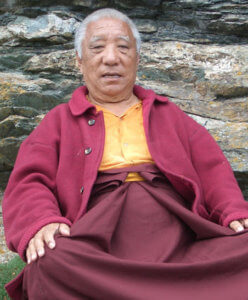
Khenpo Tsültrim Gyamtso: A Guide for Readers
Khenpo Tsültrim Gyamtso: A Guide for Readers
Khenpo Tsültrim Gyamtso Rinpoche is a Tibetan Buddhist teacher in the Kagyu tradition. Born to a nomad family in Ngangchen, Kham (the eastern region of Tibet), Khenpo Tsültrim began his training under Lama Zopa Tarchin at an early age. He later attended intensive retreats and continued his training under the lineage holder of the Karma Kagyu, the 16th Gyalwa Karmapa. Since fleeing Tibet in the late 1950's under Chinese rule, Khenpo Tsültrim continued his studies in Northern India and later settled in Bhutan. He is the root teacher of prominent Buddhist teachers such as Dzogchen Ponlop Rinpoche and Lama Shenpen Hookham and therefore plays a significant role in their respective organizations—Nalandabodhi and the Awakened Heart Sangha.
Khenpo Tsültrim teaches widely in the West and is known emphasizing the union of practice and study. He is therefore himself a prolific scholar as well as an accomplished practitioner. Below you'll find longer biography from In the Presence of Masters, a selection of books written by Khenpo Tsültrim, as well as texts written and translated by his students under his guidance.
Short Biography
From In the Presence of Masters: Wisdom from 30 Contemporary Tibetan Buddhist Teachers
Edited by Reginald A. Ray
Khenpo Rinpoche was born to a nomad family in East Tibet in 1934. Drawn to spiritual practice, he left home at an early age to train with his root guru, the yogin Lama Zopa Tarchin. After completing this early training, Tsultrim Gyamtso embraced the life of a yogi-ascetic, wandering throughout East and Central Tibet, undertaking solitary retreats in caves to realize directly the teachings he had received. He often lived in charnel grounds in order to practice and master chöd, a skillful means to cut ego clinging, develop compassion, and realize deeper levels of emptiness. Subsequently he took up retreat in the caves above Tsurphu, the seat of the Karmapas, where he received instructions on the six yogas of Naropa, the Hevajra Tantra, and other profound teachings from Dilyak Tenzin Drupon Rinpoche and other masters. Escaping to India at the time of the Chinese invasion, he was able to continue his training, studying the sutras, the tantras, and all four schools of Tibetan Buddhism He became renowned for his skill in logic and debate, and received a khenpo degree from H. H. the sixteenth Karmapa, and the equivalent geshe lharampa degree from H. H. the fourteenth Dalai Lama. In 1975 Khenpo Tsultrim established the Thegchen Shedra in Athens, Greece, and for the next ten years taught throughout Europe. Since 1985 he has traveled widely, completing annual world tours in response to invitations from Europe, the United States, Canada, South America, Southeast Asia, Africa, and Australia. In 1986 he founded the Marpa Institute for Translators, in Boudhanath, Nepal, to offer intensive courses in language and scripture. Khenpo Rinpoche continued to supervise this annual event when it moved to Pullahari Monastery above Boudhanath. While Khenpo Tsultrim Gyamtso unites prodigious intellect with great compassion, he also embodies the training and temperament of a true yogi. In fact, Rinpoche is often compared to the great yogi Milarepa, whom he resembles in both substance and style.
Books By Khenpo Tsültrim Gyamtso
Teachings on Buddha Nature and the Two Truths
Khenpo Tsultrim wrote a commentary for each of the most widely known texts in the Tibetan Buddhist tradition: Nagarjuna's Mūlamadhyamakakārikā, or Root Verses of the Middle Way, and Maitreya's Mahāyānuttaratantra Śāstra, or the Treatise on the Sublime Continuum.
In addition, Khenpo Tsultrim's Stars of Wisdom explains how to access the nature of reality pointed out in philosophical texts such as those above through analytical meditation, songs of experience, and other practical Tibetan Buddhist tools.
The Sun of Wisdom: Teachings on the Noble Nagarjuna's Fundamental Wisdom of the Middle Way
The Fundamental Wisdom of the Middle Way was written in the second century and is one of the most important works of Nagarjuna, the pioneering commentator on the Buddha's teachings on the Madhyamika or Middle Way view. The subtle analyses presented in this treatise were closely studied and commented upon by many realized masters from the Indo-Tibetan Buddhist tradition.
Using Nagarjuna's root text and the great modern master Ju Mipham's commentary as a framework, Khenpo Tsültrim Gyamtso explains the most important verse from each chapter in the text in a style that illuminates for modern students both the meaning of these profound teachings and how to put them into practice in a way that benefits both oneself and others.
Buddha Nature: The Mahayana Uttaratantra Shastra with Commentary
By Maitreya & Asanga
With Commentary By Jamgon Kongtrul Lodro Taye & Khenpo Tsultrim Gyamtso
Translated by Rosemarie Fuchs
All sentient beings, without exception, have buddha nature—the inherent purity and perfection of the mind, untouched by changing mental states. Thus there is neither any reason for conceit nor self-contempt. This is obscured by veils that are removable and do not touch the inherent purity and perfection of the nature of the mind. The Mahayana Uttaratantra Shastra, one of the “Five Treatises” said to have been dictated to Asanga by the Bodhisattva Maitreya, presents the Buddha’s definitive teachings on how we should understand this ground of enlightenment and clarifies the nature and qualities of buddhahood. This seminal text details with great clarity the view that forms the basis for Vajrayana, and especially Mahamudra, practice.
$27.95 - Paperback
By: H.H. the Fourteenth Dalai Lama & Ari Goldfield & Khenpo Tsultrim Gyamtso & Rose Taylor Goldfield
Stars of Wisdom: Analytical Meditation, Songs of Yogic Joy, and Prayers of Aspiration
By Khenpo Tsultrim Gyamtso
Translated byAri Goldfield & Rose Taylor Goldfield
By Khenpo Tsultrim Gyamtso
Tibetan Buddhist master Khenpo Tsültrim Gyamtso is known for his joyful songs of realization and his spontaneous and skillful teaching style. In this book he explains how to gain clarity, peace, and wisdom through step-by-step analysis and meditation on the true nature of reality. He also introduces readers to the joy and profundity of yogic song, and reveals the power of aspiration prayers to inspire, transform, and brighten our hearts.
Translations Under the Guidance of Khenpo Tsültrim Gyamtso
As a scholar-practitioner himself, many of Khenpo Tsultrim's students are active scholars, translators, practitioners, and authorized teachers. Below are a couple examples of translations and scholarship done under the guidance of Khenpo Tsultrim.
Maitreya's Distinguishing Phenomena and Pure Being
Translated by Jim Scott
By Jamgon Mipham
Distinguishing Phenomena and Pure Being was composed by Maitreya during the golden age of Indian Buddhism. Mipham's commentary supports Maitreya's text in a detailed analysis of how ordinary, confused consciousness can be transformed into wisdom. Easy-to-follow instructions guide the reader through the profound meditation that gradually brings about this transformation. This important and comprehensive work belongs on the bookshelf of any serious Buddhist practitioner—and indeed of anyone interested in realizing their full potential as a human being.
By Chandrakirti & The Eighth Karmapa Mikyo Dorje
Translated by Ari Goldfield, Jules B. Levinson, Jim Scott, & Birgit Scott
Under the Guidance of Khenpo Tsultrim Gyamtso
Nagarjuna, in his seminal text, The Fundamental Wisdom of the Middle Way, summarized the vast teachings of the Buddha and used logical reasoning to prove the validity of his words. Entering the Middle Way is Chandrakirti's explanation of Nagarjuna's work. Its sixth chapter, which comprises the majority of the text, has four main sections: an explanation of how in genuine reality phenomena do not truly arise; a refutation of the Mind-Only School's assertion that mind truly exists; a refutation of the true existence of the personal self; and an explanation of the sixteen emptinesses taught by"the Buddha in the Transcendent Wisdom Sutras. The Moon of Wisdom is thus a book that explains the Buddha's ultimate teachings, how to gain confidence in them, and how to put them into practice in one's"own life to the great benefit of oneself and others.
Additional Books by Khenpo Tsultrim's Students and Lineage
As mentioned above, Khenpo Tsultrim has had many prolific students over the years owing to his focus on cultivating practitioners that are both engaged in traditional practice and scholarship. Prominent students include Dzogchen Ponlop Rinpoche, and Lama Shenpen Hookham. In addition to these two, there are a number of translators and senior students from Khenpo Tsultrim's lineage with a remarkable practice and scholastic history including Karl Brunnhölzl and Elizabeth Callahan. These examples of teachers and senior students are just a few illustrations of the flavor and style of teaching and practice presented by Khenpo Tsultrim Gyamtso.
Dzogchen Ponlop Rinpoche

Rebel Buddha: A Guide to a Revolution of Mind
There’s a rebel within you. It’s the part of you that already knows how to break free of fear and unhappiness. This rebel is the voice of your own awakened mind. It’s your rebel buddha—the sharp, clear intelligence that resists the status quo. It wakes you up from the sleepy acceptance of your day-to-day reality and shows you the power of your enlightened nature. It’s the vibrant, insightful energy that compels you to seek the truth. READ MORE

The Guru Principle: A Guide to the Teacher-Student Relationship in Buddhism
Based on over fifty years of personal experience as both a student and a teacher, Lama Shenpen Hookham writes candidly of the opportunities and challenges facing modern Dharma students who wish to study with a teacher. Traditional texts often do not reflect how the student-teacher relationship really works in practice, which leaves many pressing questions in communities taking root in the West. With honesty and clarity, Lama Shenpen discusses the roles of the teacher, practices related to the guru, and commonly asked questions she receives as a teacher. This handbook is the first of its kind, breaking down in a pragmatic and relatable way everything one needs to know to enter a student-teacher relationship with open eyes and an open heart.
Karl Brunnhölzl

The Center of the Sunlit Sky:Madhyamaka in the Kagyu Tradition
Madhyamaka is a potent and universally accessible means of calming our suffering and awakening to our innate wisdom. The Center of the Sunlit Sky artfully rescues this brilliant teaching from its unwarranted reputation for intellectual opacity and reinstates it as a supremely practical tool kit for everyday living. The aim of this book is to take Madhyamaka out of the purely intellectual corner into which it unjustly gets boxed. It is an attempt to show how Madhayamaka actually addresses and works with all of our experiences in life. READ MORE
Learn more about Karl Brunnhölzl's here: The Works Of Karl Brunnhölzl: A Guide For Readers
Elizabeth M. Callahan
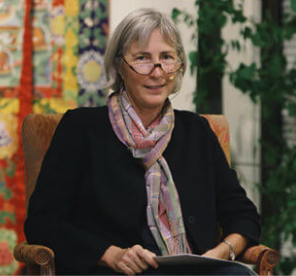
Marpa Kagyu, Methods of Liberation Part 1 from The Treasury of Precious Instructions
By Jamgon Kongtrul Lodro Taye
Translated by Elizabeth M. Callahan
The seventh volume of the series, Marpa Kagyu, is the first of four volumes that present a selection of core instructions from the Marpa Kagyu lineage of Tibetan Buddhism. This lineage is named for the eleventh-century Tibetan Marpa Chokyi Lodrö of Lhodrak who traveled to India to study the sutras and tantras with many scholar-siddhas, the foremost being Naropa and Maitripa. The first part of this volume contains source texts on mahamudra and the six dharmas by such famous masters as Saraha and Tilopa. The second part begins with a collection of sadhanas and abhisekas related to the Root Cakrasamvara Aural Transmissions, which are the means for maturing, or empowering, students. It is followed by the liberating instructions, first from the Rechung Aural Transmission. This section on instructions continues in the following three Marpa Kagyu volumes. Also included are lineage charts and detailed notes by translator Elizabeth M. Callahan.
Learn more about this series here: A Guide to the Treasury of Precious Instructions
Related Books from the Kagyu Tradition of Tibetan Buddhism

The Treasury of Precious Instructions Video Series

Explore the Treasury of Precious Instructions
Page Navigation Menu
Home Page of the Treasury
History of the Treasury of Precious Instructions
The Books: Overviews of Each Volume
Jamgön Kongtrul's Descriptive Catalog (Karchag)
> Video Series (for the Treasury of Precious Insturctions)
Audio Streaming and Podcast
Matthew Kapstein on Dam Ngak (special instruction) based on the Treasury
Tibetan Resources on the Treasury from the Tsadra Foundation
Readers Guide to Jamgōn Kongtrul
In 2016, the Tsadra Foundation sponsored a series of talks on the Treasury of Precious Instructions focusing on Kongtrul and the specifics of the Eight Chariots. Translator and teacher Sarah Harding who has been immersed in this work for decades and has completed several volumes of this work leads it. Also included are Elizabeth Callahan and Acharya Tenpa Gyaltsen. You can watch or download the full series here.

Overview
In this talk, Sarah Harding, translator of several volumes of the Treasury, gives an overview of the Treasury and a peek into what is in store in subsequent videos in this series. She discusses how the Jonang volume, the final one in the series, is in fact the keystone and inspiration for the entire collection.
Nyingma, Kadam, and Sakya Lamdre
In this talk, Sarah Harding, translator of several volumes of the Treasury, discusses the Nyingma, Kadam, and Lamdre traditions which make up the first six volumes of the series.
The Marpa and Shangpa Kagyu
In this talk, Elizabeth Callahan and Sarah Harding present the six volumes based on instructions from the Shangpa and Marpa Kagyu traditions.
Zhije and Chöd
In this talk, Sarah Harding discusses the volumes on Zhije (Pacification) and Chöd (Severance).
Kalachakra and Orgyen Nyendrup
In this talk, Sarah Harding is joined by Lama Tenpa Gyaltsen to discuss the Kalachakra and Orgyen Nyendrup traditions as well as reflecting on Kongtrul's Treasury as a whole.
Continue to next page: Audio Streaming and Podcast (for the Treasury of Precious Instructions)

The Treasury of Precious Instructions Audio Series

Explore the Treasury of Precious Instructions
Page Navigation Menu
Home Page of the Treasury
History of the Treasury of Precious Instructions
The Books: Overviews of Each Volume
Jamgön Kongtrul's Descriptive Catalog (Karchag)
Video Series (for the Treasury of Precious Instructions)
> Audio Streaming and Podcast
Matthew Kapstein on Dam Ngak (special instruction) based on the Treasury
Tibetan Resources on the Treasury from the Tsadra Foundation
Readers Guide to Jamgōn Kongtrul
In 2016, the Tsadra Foundation sponsored a series of talks on the Treasury of Precious Instructions focusing on Kongtrul and the specifics of the Eight Chariots. Translator and teacher Sarah Harding who has been immersed in this work for decades and has completed several volumes of this work leads it. Also included are Elizabeth Callahan and Acharya Tenpa Gyaltsen. You can listen or download the full series here.

Overview
In this talk, Sarah Harding, translator of several volumes of the Treasury, gives an overview of the Treasury and a peek into what is in store in subsequent videos in this series. She discusses how the Jonang volume, the final one in the series, is in fact the keystone and inspiration for the entire collection.
Nyingma, Kadam, and Sakya Lamdre
In this talk, Sarah Harding translator of several volumes of the Treasury, discusses the Nyingma, Kadam, and Lamdre traditions which make up the first six volumes of the series.
The Marpa and Shangpa Kagyu
In this talk, Elizabeth Callahan and Sarah Harding present the six volumes based on instructions from the Shangpa and Marpa Kagyu traditions.
Zhije and Chöd
In this talk, Sarah Harding, discusses the volumes on Zhije (Pacification) and Chöd (Severance).
Kalachakra and Orgyen Nyendrup
In this talk, Sarah Harding is joined by Lama Tenpa Gyaltsen to discuss the Kalachakra and Orgyen Nyendrup traditions as well as reflecting on Kongtrul's Treasury as a whole.

